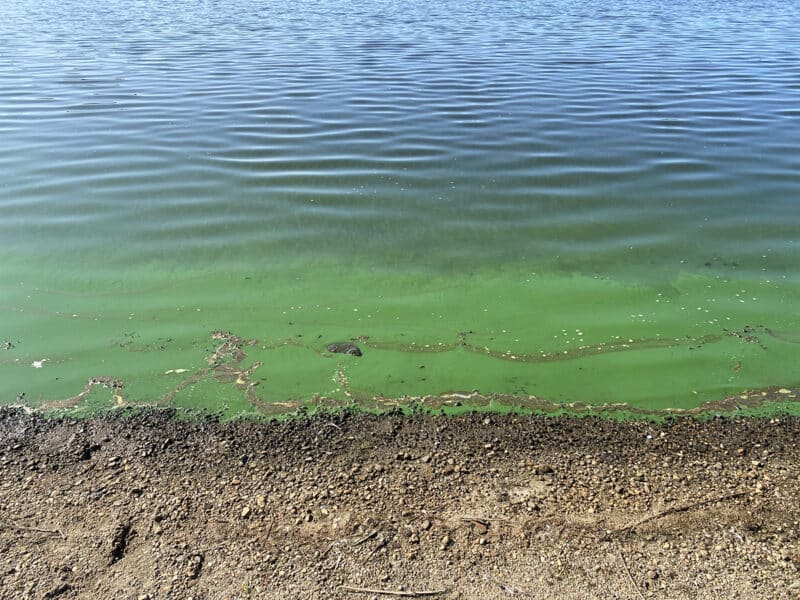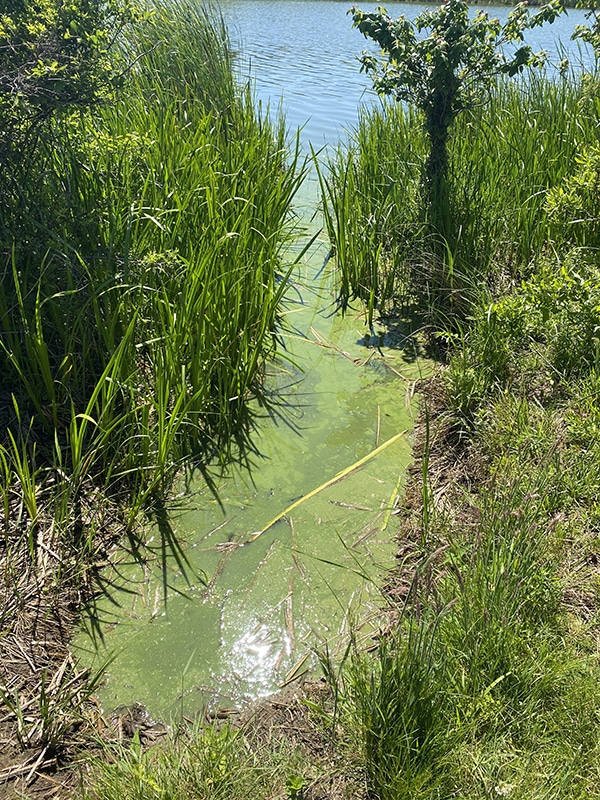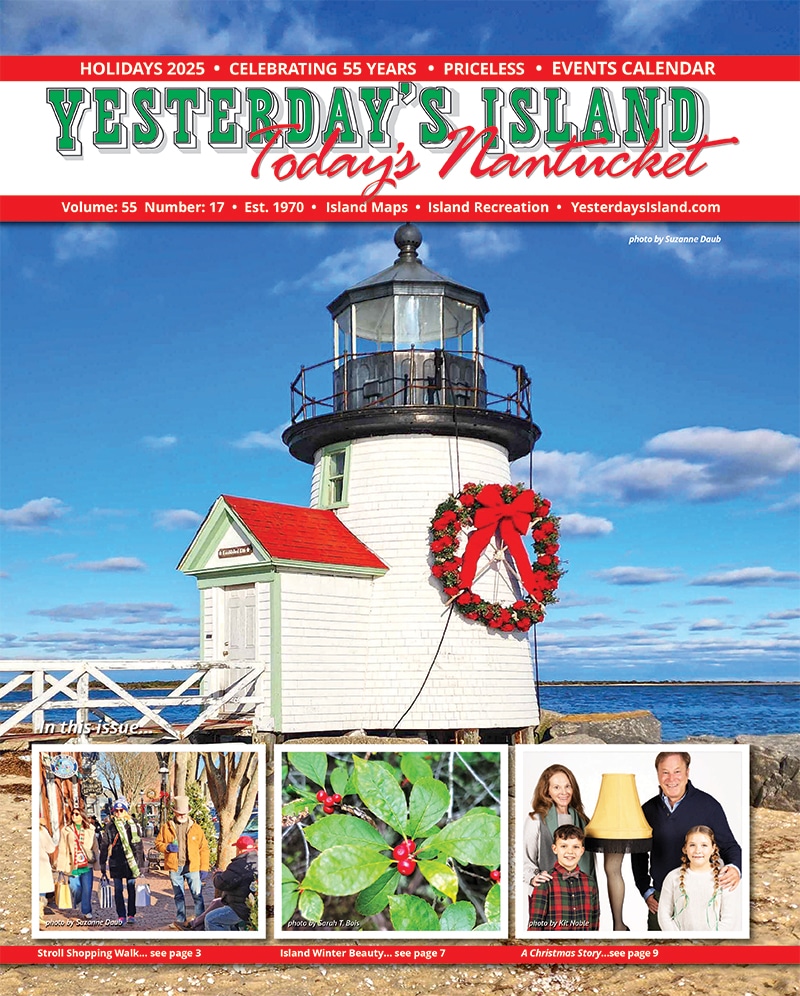by Dr. Sarah Treanor Bois, PhD
Director of Research & Education at the Linda Loring Nature Foundation
When I was a kid, the first movie I ever saw in 3D was The Creature from the Black Lagoon. The movie was from 1954, but in the 1980s the VHS tape was released, and we all had the special glasses. It was fun in the watching and seemed sort of ridiculous. However, as a 7-year-old, it instilled a fear of freshwater in me that was hard to shake. I wouldn’t go into a pool or lake for the rest of the summer without thinking about the swamp man.
While I eventually got over my fear of the creature, there is now another green, slimy, and menacing thing in some of our ponds and waterways wreaking havoc on Nantucket. They may be small, but they can cause more harm than a person in a swamp man costume. I’m talking about Harmful Algal Blooms.
What is a harmful algal bloom?
First, let’s start with algae. Algae colonies are simple plants that live in the sea and freshwater. These photosynthetic organisms are a beneficial part of natural environments—only a few are harmful. They are at the bottom of the food chain in all natural environments and are an important food resource in our ponds and other waterways.
An algal bloom is a rapid increase in the density of algae in an aquatic system. Algal blooms sometimes are natural phenomena, but their frequency, duration, and intensity are increased by a rise in nutrients as well as temperature and sunlight. Algae can multiply quickly in waterways with an overabundance of nitrogen and phosphorus, particularly when the water is warm and the weather is calm. This proliferation causes blooms of algae that turn the water noticeably green, although other colors can occur. Some species of algae grow in clumps covered in a gelatinous coating and have the capability to float, allowing cells to stick together into large surface scums in calm weather. Other algae form thick mats that float on or just below the surface along a shoreline. A perfect recipe for a swamp monster!
There are many kinds of harmful algal blooms (HABs), caused by a variety of algal groups with different toxins. Different species thrive and bloom in fresh vs marine environments. The CDC defines harmful algal blooms, or HABs, as “the rapid growth of algae or cyanobacteria in water that can produce toxins or otherwise harm people, animals, or the environment.”
Swimming in water with HABs, and incidentally ingesting it, can lead to stomach trouble, headaches, fever, and fatigue. HABs have been associated with human health impacts, including skin rashes, gastrointestinal and respiratory disease, and liver damage. Animals, including dogs, can also be impacted by HABs, with more pronounced effects that can potentially be fatal.
A few years ago I ran into a fellow dog-walker on a familiar trail near Miacomet Pond. Our dogs (both labradors) were leashed, so it was easy to keep them out of the water. However, she told me that her dog had gotten severely sick the year prior when he played with and chewed a tennis ball that had been in the pond soaking up pond water. Even the relatively small amount of water from a soaked tennis ball caused the labrador to need medical attention. After a round of strong antibiotics, he was OK, but it served as a warning: keep dogs away from HABs and that includes other things (balls, toys, leashes) that have also been in polluted pond water.
So what causes these blooms and how can we avoid them in the future?
The increase in HABs in the past several years is due to a couple of factors. One is increase in awareness: more people know about them, monitor for them, and there is an active outreach campaign to inform the public. The primary reason, however, is an increase in nutrients into Nantucket ponds. An overabundance of the essential plant nutrients—nitrogen and phosphorus—are the primary reason for blooms, and this influx of nutrients occurs form various pollution sources. On Nantucket, the primary sources attributed to HABs are fertilizer runoff and leaching septic systems. Though nitrogen and phosphorus occur naturally and are essential plant nutrients, an overabundance of these nutrients can cause significant imbalances in the water body’s ecology, and blooms are one symptom. Increase in water temperatures of pond water contributes to the algal growth. For our ponds, which have little to no outflow, coupled with warmer temperatures, it is a perfect set of conditions to breed HABs.
What is Nantucket doing about HABs?
The Nantucket Land and Water Council have been leaders in sampling our Nantucket water bodies and identifying HABs over the years. Their pond sampling program includes the identification and enumeration of species found within the water column. Determining the species present is the first step in determining whether or not a HAB could be dangerous.
Led by Water Resource Specialist Emma Morgan, the Town of Nantucket now works collaboratively with the Nantucket Land & Water Council, Linda Loring Nature Foundation, Nantucket Conservation Foundation, UMASS Boston, Mass Audubon, and Nantucket Islands Land Bank to monitor a number of island ponds for HABs on a weekly basis from June to October. To see a map of these locations and to stay informed about local HABs visit: nantucket-ma.civilspace.io/en/projects/ harmful-algal-blooms-monitoring-program. According to the Town’s website: “The Nantucket HAB monitoring team collects samples and conducts visual inspections…to determine the presence or absence of potentially toxic algae. The duration of a HAB occurrence is dependent on several factors, including physical and biological conditions, and therefore is not possible to predict in advance.”
Those monitoring for HABs look for visual clues in the waterbody. Generally, there is a green and sometimes slimy mass on the surface of the water. They can be dense mats and may look like green paint or scum; they can also cause foul odors. If a HAB is detected, as a first step, a red sign indicating that a HAB is present is posted. The signs are in English and Spanish and alert people to the potential danger. If you see this sign, do not recreate in that pond.
That observation is then reported to the Town via an online reporting form. Every week, the Town puts out a list of waterways with known HABs. The organizations that participate also often share that info, which comes out on Friday mornings. New for 2024, the collaborative team also takes samples of the water every other week to learn more about the algae and cyanobacteria in the ponds.
There are opportunities to “adopt a pond” as well for areas you may frequent, and to report a potential HAB, use the online form found at townofnantucket.typeform. com/to/ylf5CGky?typeform-source=nantucket-ma.civilspace.io.
Even though there is an active sampling and monitoring program for HABs, it is important to remember that the best way to “cure” a HAB is to prevent it in the first place. Some of the best things we can do as a community is to reduce or eliminate fertilizer applications, especially in areas that abut our waterways, and make sure you have properly sized septic for the size of the dwelling or hook up to sewer where possible.
What should you do if you think you see a HAB in a pond? Well, first step is to use caution and not recreate in the pond. Keep pets out as well. It’s a good rule of thumb that if the water is green and smells weird, stay out! It may not look like a creature from the black lagoon, but it might just be more dangerous to your health.




